Incubating and
Hatching Chicken, Duck & Turkey Eggs
The information
here is from the Western
North Carolina Farm and Garden Calendar for USDA Zones 5, 6, and
7 for all eastern states. It is a 280 page book that I wrote.
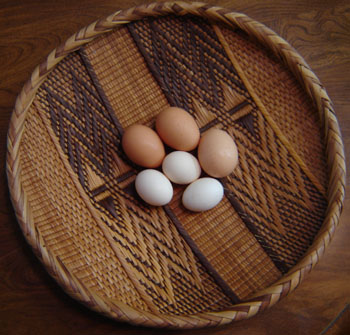
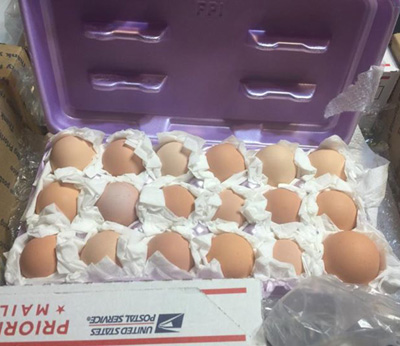 |
Incubate
Poultry January through August/September
It is good
to incubate eggs January through August when egg production is at its highest.
However, for my Dominique chickens I sometimes have hatching eggs all year.
In terms of availability of hatching eggs, peak egg production is March,
April and May. Good egg production is late January through July.
Lowest egg production is September through December. (The longest day is
in June. Molting is in September. The shortest day is in December.)
You can incubate poultry eggs in an incubator such as a HovaBator or Brinsea.
Read the manual that came with it. Or you can build your own incubator.
Or let a broody hen do it.
Frequently when people buy an incubator, they later wish they had bought
a better (more expensive) one.
It is best if the incubator is in a room with a stable temperature around
70-80 degrees. Do not let sun hit the incubator.
This photo is Dominique eggs that were shipped by me through the Post Office
to Dolly and Richard in Mississippi.
|
|
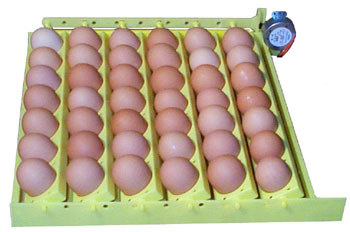 |
Collecting
Eggs
Before a fertile egg is incubated, the embryo inside is already developing.
Collect eggs frequently. Clean lightly soiled eggs with a dry, soft cloth.
It is better not to wash them since they have a bloom that keeps bacteria
out.
But if you must wash them, use warm but not cold water. Do not incubate
eggs that are very dirty because bacteria may have gotten into the egg.
Handle gently.
|
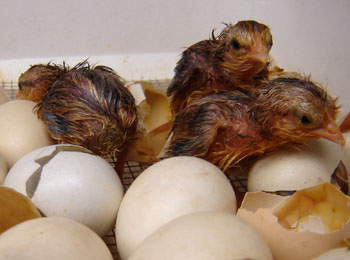
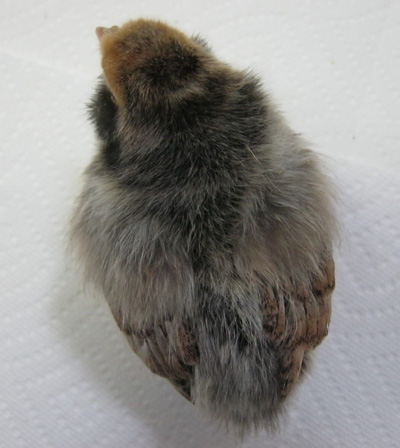 |
Storing
Eggs for Incubation
It is best
to incubate them within 1-2 weeks. If you only have a few hens and need
to wait a few days or weeks to collect enough eggs for your incubator, then
keep them around 50-60 degrees and 75% relative humidity. (Best hatch rate
is with eggs stored less than 1 week.)
Do not put in refrigerator. Put them in an egg carton with the big end of
the egg up. Then 2-3 times a day lift up one end of the carton, then the
next time the other end. Do not turn upside down.
Let eggs warm to room temperature before putting them in incubator.
These photos are Cream Brabanter chicks.
"Your site has been AWESOME. I can't tell you how often I have referenced it in the last few months especially. You helped me through my first hatching." -Meredith, Hopkins, Michigan
"Ancona duck eggs made it today! So excited. We had the incubator prewarmed and let the eggs sit on the counter for several hours before we put them in. The eggs are beautiful and surprisingly heavy!" -Michele, Maggie Valley, North Carolina
|
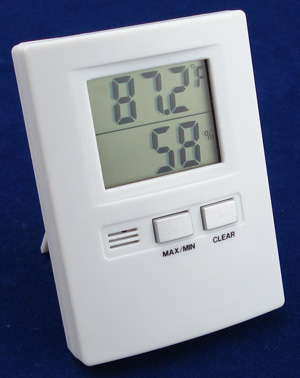
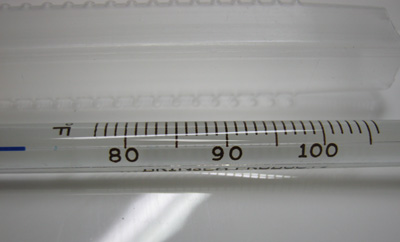
|
Incubator
Temperatures
Chicken eggs
are incubated at 99 to 99.5 degrees. Chicken eggs incubate for 21 days.
Your countdown for days starts when you put your eggs in your incubator.
It does not start when the hen lays her eggs.
Duck eggs are incubated at 99 to 99.5 degrees. Mallard and domestic duck
eggs (including Ancona) incubate for 28 days. Muscovy duck eggs incubate
for 35 days. You start counting your days when you put the eggs in your
incubator.
Turkey eggs incubate between 98-102 degrees with 99-100 degrees being best.
Turkey eggs incubate for 28 days.
About 2/3 the way through incubation, the babies in the eggs start generating
some heat. So you may need to turn the thermostat down if the temperature
rises too much.
"All 8
of the Ancona duck eggs are still progressing right on schedule, and I am
ecstatic! One egg lost a bit too much weight and has a larger air cell than
the others, but the duckling inside is still progressing and moving well.
The other eggs are right on track with both weight loss and air cell development.
They are all due to hatch a week from tomorrow." -Shelly, Norman, Oklahoma
|
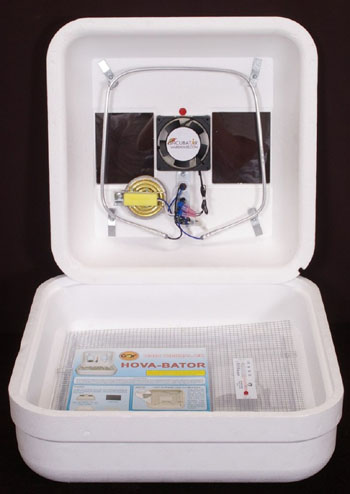 |
Incubator
Humidity
Different
humidities work in different incubators at different times of the year.
It depends on your particular incubator, how humid the outside air is, and
how porous these particular eggs are.
Chicken eggs need 50-55% humidity for days 1-18, and 65-75% for days 19-21.
Duck eggs like 55-65% humidity for days 1-24. From day 25 to first piping
(ducklings start to crack egg, usually around day 28), humidity should be
around 65-75%. When piping starts, increase humidity to 80-85%.
Turkey eggs like 55-60% humidity for days 1-24. From day 25 to hatch, humidity
should be around 75-80%.
The photo to the left is a Hova-Bator.
|
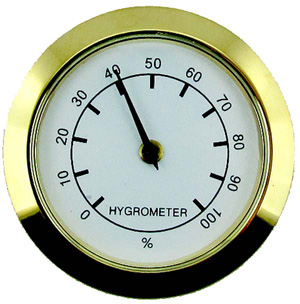
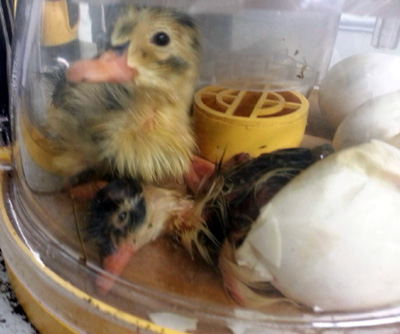
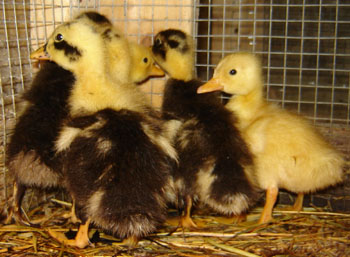 |
Incubator
Use and Humidity
Different
incubators hold different numbers of eggs. An "Octagon Incubator"
holds 24 chicken eggs. A "Little Giant Incubator" holds 30 chicken
eggs. A "HovaBator Incubator" holds 42 chicken eggs. A "Farm
Innovators Incubator" holds 48 eggs.
You can use the same incubator for hatching chicken, duck or turkey eggs.
Since the number of days of incubation is different, you hatch them so all
eggs are the same type for each batch.
You need a hygrometer (humidity gauge). Keeping the right humidity is very
important. It is better to have higher than recommended humidity than lower
especially when eggs are hatching. If it is too dry, the birds will have
difficulty getting out of the egg.
Open the incubator only when absolutely needed such as adding water to maintain
humidity. Most incubators have small holes at the top where you can add
water with a funnel. Water is usually added about 2 times per week. Check
your humidity gauge.
Opening the incubator changes the temperature and humidity that can take
hours to readjust.
"I would
say the use of the temperature / humidity monitor separate from the one on
the incubator was key to our success this time hatching duck eggs. I also
kept the humidity at 65% throughout and pushed it up to 85% on lockdown
day 25, and I misted the eggs every other day with very warm water."
-Lynn Ann, Sellersville, Pennsylvania
|
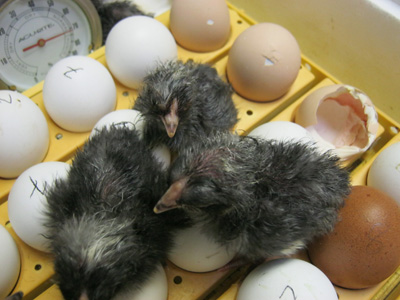
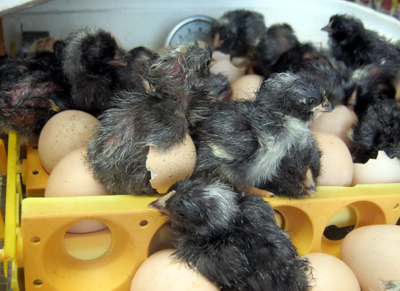
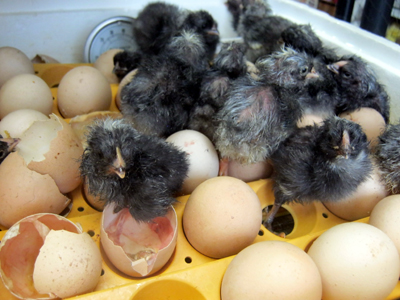
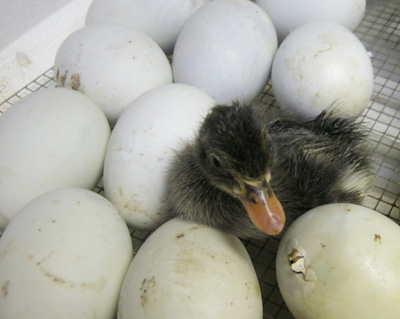 |
Incubator
Turning Rack
It is best
to have an electric turning rack. Eggs are put in the turner with small
ends down. The turner moves very slowly.
Or you can turn eggs by hand 3-4 times a day. Put a block/brick/book under
one side of the incubator to make a 45 degree angle. Then switch sides,
going back and forth each time. Turning prevents the embryo from sticking
to the shell.
Do not turn the last 3 days. Remove turner and put eggs on side on incubator
floor.
Or keep eggs in turner and turn off the electric when the racks are level.
The advantage to keeping them in the racks is that the floor temperature
is cooler than the rack temperature. So the egg temperature is kept stable.
Also the babies in the eggs have adjusted to a certain position so not moving
them may make it easier for them to get out of their shell.
These 2 photos show hatches I have done both ways.
First Pip
to Unzip to Out of Shell
It is usually 12-18 hours from pipping (first hole in egg) to hatching,
though it can take up to 48 hours. It is called unzipping when the baby
chips at the egg in a circle.
There can be up to a 4 day difference between when the first baby hatches and the last one hatches. So let the incubator run more than 21 (chicken) or 28 (Ancona duck) days, just in case.
"One more
duck did hatch out, 2 days after the first 3 hatched. That brought the total
to 4 out 6. Not bad. I almost, almost, shut the incubator down before that
last one hatched." -Chris & Chrissey, Greenfield Center, New York
|

|
Video
of Ancona Duckling Hatching
YouTube Video of Ancona Duckling Hatching.
The video is from Anya in Durham, North Carolina. It is great to watch the
duckling get out of the shell. I was rooting for him. Fun to watch.
|
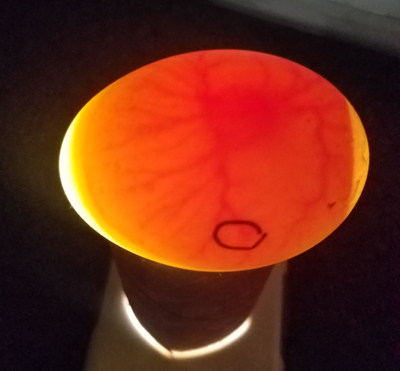
Duck egg at
6 days from Jaime in Springfield, Vermont.
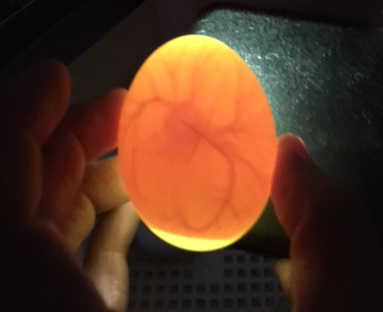
Duck
egg at 7 days from Allison in Citrus Heights, California.
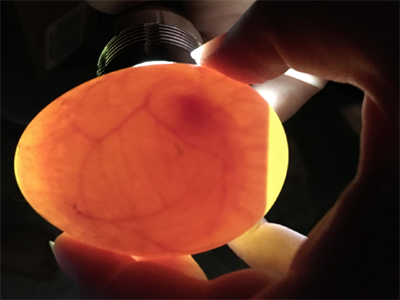
Duck egg at 8 days.
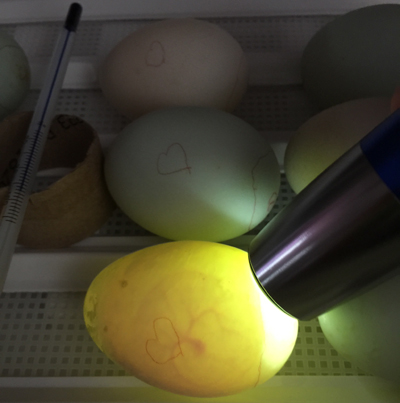
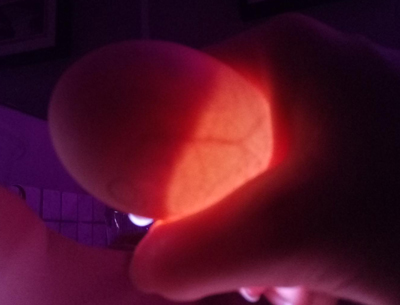
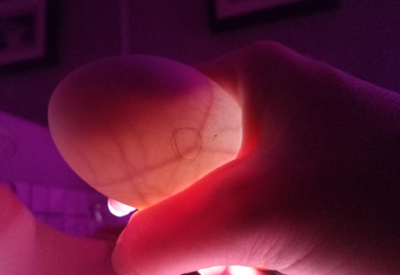
Duck eggs
at 14 days from Joy in Bellevue, Washington.
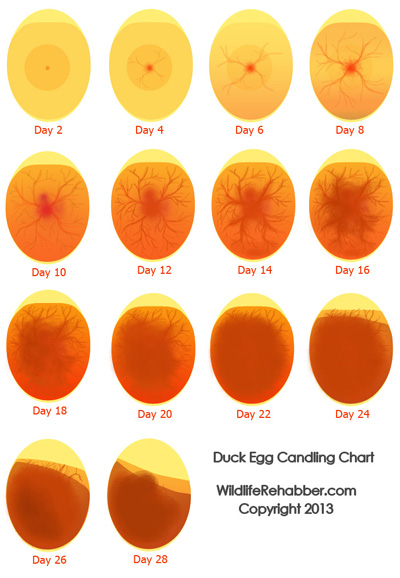
|
Candling
Eggs: Chicken & Duck
"This experience has been so interesting and fun to watch even with our newbie trial and error. So thank you for such beautiful eggs :). Candling eggs has seriously been one of the coolest experiences I have ever had with any farm or pet animals. It reminded me so much of ultrasounds I had of my own children. LOL I was almost as excited seeing the baby chicks growing!!" -Heather, Greeley, Colorado
You can candle
eggs which means looking at the eggs in the dark or in dim light with a
flashlight touching the egg to see if the eggs are fertile and growing properly.
You throw away infertile (clear) or dead (cloudy) eggs.
You do not have to candle eggs at all if you don't want to. The less eggs
are moved the better.
You can candle eggs at day 1 (when you receive your eggs) and after 7 days
in the incubator.
"We are at night 6 of incubation and doing well. I have never done this independently so I think it's going well. We candled the eggs tonight, and 10 out of the 12 eggs appear to be growing. I attached a picture of one of them I candled. The kids were so excited, even my 17 year old. Again, thank you so much! Will keep you posted as we progress." Jaime, Springfield, Vermont
Candle again at day 14 or 18 if there were eggs that you were uncertain
about. Otherwise, you do not need to candle again.
"Kevin
candled the Dominique eggs last night and it's a 100% fertility. No eggs
were pulled, all 53 eggs are still incubating. Thank you. :)" -Dolly,
Magnolia, Mississippi
Later update: "Kevin is moving the eggs to the hatcher for lockdown.
He said two did not develop so that leaves 51 going to lock down." -Dolly
"I just picked up the babies from Kevin. 45 hatched (out of 53). Thank
you :)" -Dolly
The photo of the duck eggs with the hearts on them is from Shelly
in Norman, Oklahoma. You can see the veins in the egg. There is a Brinsea
incubation thermometer in the photo. YouTube
Video of candling eggs, 25 seconds.
"I use the 1502 Digital Sportsman incubator from GQF Manufacturing. No
water for 18 days and then add water to the water pan on lockdown. Other
than that I don't touch them. Just candle them on day 7 and 18 before lock
down. During lockdown I open it once a day and fill the water pan."
-Kevin, Purvis, Mississippi
Here is an Ancona duck egg candling video from Eagle Flight Farm:
YouTube
Video of candling, 28 seconds.
|
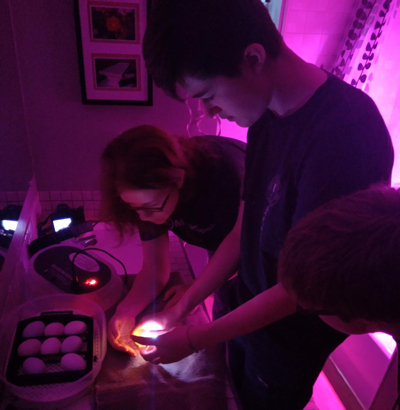
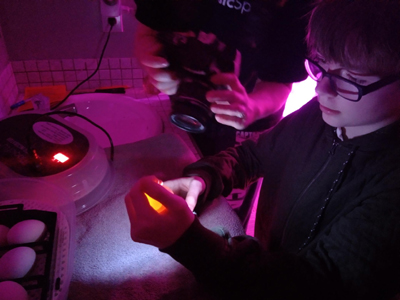
|
Family
Fun
"7
of 8 are doing nicely throughout the egg with good healthy veins and some
visible movement. One of the healthy eggs has a ton of movement, and I thought
I saw 2 distinct areas of movement last week." -Joy, Bellevue, Washington
These 2 candling photos are from Joy.
YouTube
Video of candling duck eggs at 2 weeks, for 37 seconds from
Joy.
"All
8 fertile eggs look pretty much the same. Lots of veins, shadows, and some
movement."
|
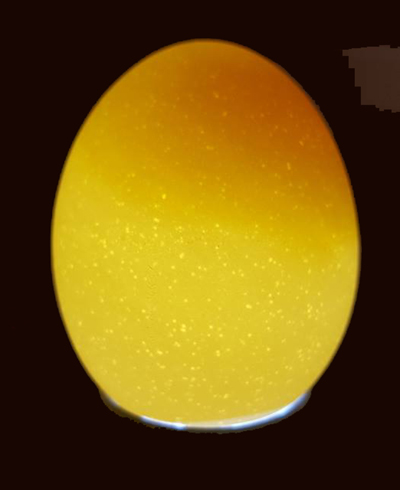
Chicken egg that is not fertile.
Below are chicken eggs. They hatch in 21 days.
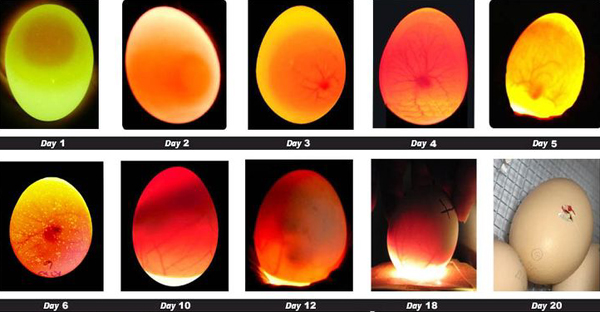 |
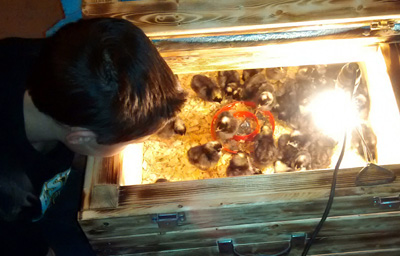 |
Dominique
Chicks
This is a photo of Dolly's Dominique chicks that Kevin hatched. Happiness
for everyone.
|
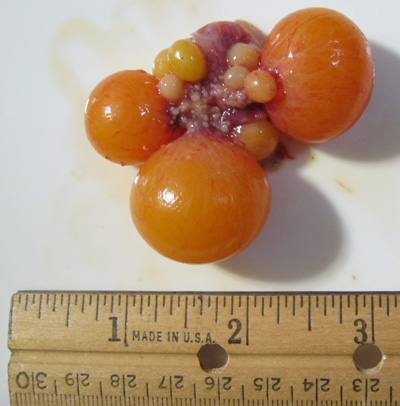
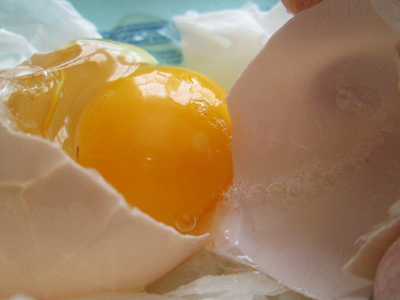 |
Eggs
Inside Hen
This unusual
photo is from the inside of a hen. You can see how the yolk develops from
tiny eggs, getting larger and larger going around in a circle. The yolk
is produced by ovulation.
The yolk is fertilized by sperm before the shell is added. The process is
the same whether or not the egg is fertilized. You do not need a rooster
for an egg to be laid. Though it can not grow into a chick.
The eggshell, membrane, and white is added to the yolk as it moves down
the oviduct of the hen. The oviduct is a long, spiral tube in the hen's
reproductive system. The shell is made of calcium carbonate.
The second photo is a perfectly formed egg. The photo is from Kelly in Raeford,
North Carolina.
"I opened up an egg to show the kids the difference between store egg yolks vs farm produced. I'm so looking forward to having fresh eggs again, these yolks are gorgeous!!!" -Kelly, Raeford, North Carolina
|
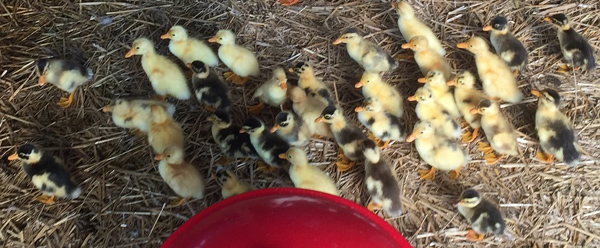
This photo of Ancona ducklings was taken by Jason in New Martinsville, West Virginia.
|

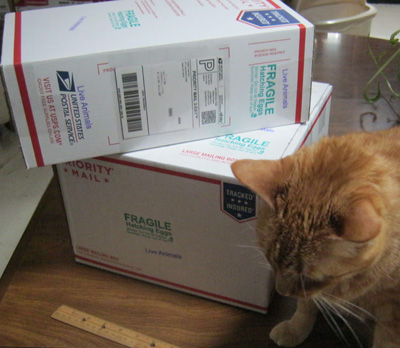
Boxes of hatching eggs ready to ship through the Post Office.
Hatching Eggs for Sale
|




























